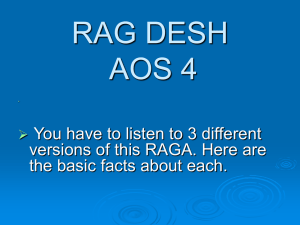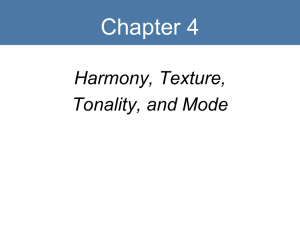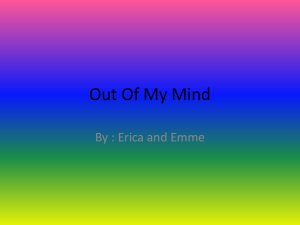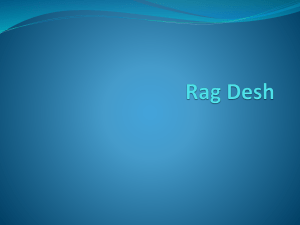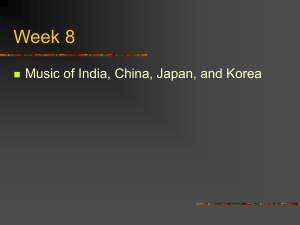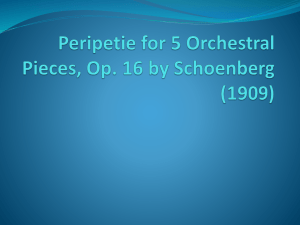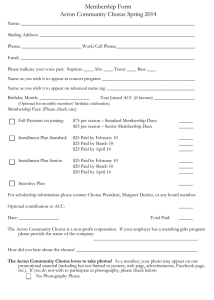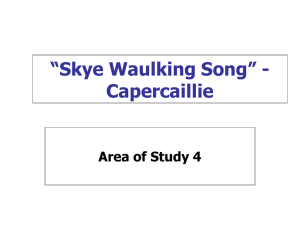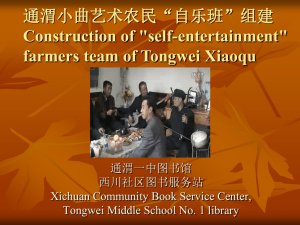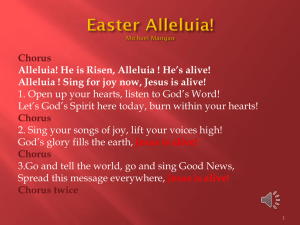Click on this to access the Powerpoint for revision
advertisement
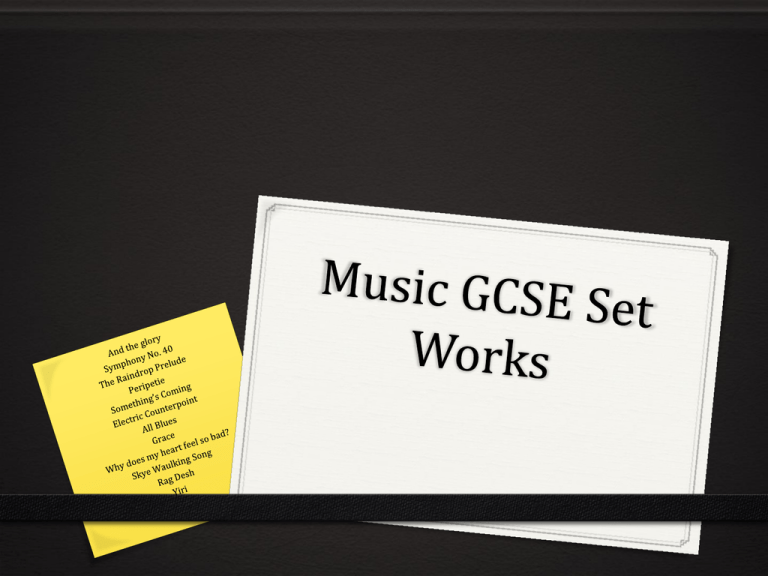
And the Glory of the Lord – Handel Tonality and Harmony Texture Orchestration Melody and Word-setting Rhythm and Tempo Dynamics A major, modulates to E major, and B major twice Changes frequently String orchestra Four contrasting melodies of the chorus: Allegro, ¾ Terraced dynamics Frequent cadences, often perfect Plagal cadence at end Homophonic passages: used for dramatic effect, usually syllabic Polyphonic passages: polyphony created through use of sequences and imitation Occasional, short monophonic passages Continuo bass line – organ, cello, double bass Four-part choir: SATB ‘And the glory’ – A major triad at start, syllabic ‘Shall be revealed’ – melismatic, smooth descending outline ‘And all flesh’ – melismatic, repetition for reinforcement ‘For the mouth’ – syllabic, tonic pedal, repeated long notes to reinforce meaning of words Hemiola ends some sections Adagio after dramatic three beats rest near end Long notes make words seem more important than music Dynamics determined by number of instruments playing Piece starts quietly Piece ends loudly Symphony No. 40 – Mozart Tonality and Harmony Texture Structure Orchestration Melody Rhythm and Tempo Dynamics Exposition: 1st subject in G minor, 2nd subject in Bb major Mostly homophonic Sonata form: Chamber orchestra made up of strings, woodwind and horns Balanced, graceful melodic lines that sound like question and answers. E.g. 2nd subject starts with a four-bar phrase that ends with an imperfect cadence (question), followed by a four-bar phrase that ends with a perfect cadence (answer) 4/4 throughout Most dynamic contrasts occur suddenly Development: explores different keys Recapitulation: both subjects in G minor Coda: repeated perfect cadences in G minor Diatonic and functional harmony Chromatic chords Pedal notes (end of 1st subject and end of bridge) Imitation Octave doublings Dialogue between woodwind and strings (start of 2nd subject) Exposition Development Recapitulation And Coda No trumpets or timpani = unusual for classical orchestra Two horns in different keys (G and Bb) to maximise number of notes they can play between them Strings: busy most of time Woodwind: don’t play quite so much, share start of 2nd subject with strings Molto Allegro 1st subject: two quavers followed by a crotchet Transition: loud Many phrases are scalic Contrasting melodies in 1st and 2nd subject: First subject: a melody that is characterised by a falling motif first played by strings Second subject: a melody with descending chromatic patterns, shared between woodwind and strings The 1st and 2nd subjects in the recapitulation are repeated with some variation EXPOSITION First subject: mainly quiet Rhythms are fairly simple, although some dotted rhythms and syncopation 2nd subject: begins quietly, gets louder towards end DEVELOPMENT: starts and ends quietly, loud section in middle RECAPITULATION: similar dynamics to the exposition The Raindrop Prelude - Chopin Tonality and Harmony Texture Structure Use of piano Melody Rhythm and Tempo Dynamics D major, modulates to C# minor (enharmonic minor) Mainly homophonic texture Ternary form with a short codetta: ABA Much of prelude uses middle and lower ranges of the piano Lyrical melody in RH at start 4/4 Section A and B both end with imperfect cadences, but the piece ends on a perfect cadence Diatonic harmony with occasional chromaticism Dominant pedal (A s/G#s) Section A: melody in RH, broken chords in LH Section B: more chordal. melody passes to LH, with repeated quavers in RH Section A: back to opening texture. Short monophonic passage in the coda Section A: major, lively Section B: minor, chordal Legato, singing tone produced Sustain pedal used Wide dynamic range Sostenuto Wide range, no sudden contrasts Ornamentation e.g. acciaccturas, turns Gentle ritenuto at end Crescendos and diminuendos Raindrop notes: G#s/Abs – repeated quavers are a unifying rhythmic feature throughout Starts p ends pp Section B: melody moves to bass Rubato = flexible tempo for expressive effect Unusual rhythmic features: septuplets, dectuplets Sotto voce b28 Section A: quieter than section B, which climaxes to ff twice Peripetie – Schoenberg Tonality and Harmony Texture Structure Orchestration Melody and Wordsetting Rhythm and Tempo Dynamics Atonal Largely contrapuntal Free rondo form with 5 sections: ABACA Large orchestra Short, fragmented motifs Starts in ¾, but metre changes between 3/4, 2/4 and 4/4 Sudden changes of dynamics, leading to extreme contrasts between ppp and fff Dissonant harmony Hexachords Occasional monophonic and homophonic moments Complex textures built up through use of imitation and inversion Instrumentation changes rapidly Instruments required to play at extremes of pitch ranges Unusual effects e.g. cymbals played with both a cello bow and a mallet Disjunct Octave displacement Sehr rasch (very quick) Inversion Rhythms: complex and varied Rhythmic augmentation Starts loudly, ends with pp chord Something’s Coming – Bernstein Tonality and Harmony Texture Structure Orchestration Melody and Word-setting Rhythm and Tempo Dynamics D major, with two contrasting sections in C major Homophonic Does not follow conventional verse-chorus structure Solo tenor accompanied by a band made up of woodwind, brass, percussion and strings Mostly syllabic Fast tempo Starts pp Alternation of three main themes: 1 – quiet syncopated opening theme 2 – loud, strident theme in 2/4 (b21) 3 – lyrical, slow-moving theme Frequent syncopation, push rhythms Much contrast A: mostly syllabic, often scalic Accompaniment: largely made up of an on-beat bass part with off-beat chords = create cross rhythms at star Tonal and Jazz influenced harmony with blues notes e.g. tritone and flattened 7ths (e.g. C natural against D major harmonies at end) – note remains unresolved and fits in well with the sense of expectation Accompaniment: uses quiet dynamics, soft timbre (e.g. muted trumpets, pizz strings) = don’t overpower the singer B: made up of repeated notes C: made up of wider intervals Word-setting: ‘the air is humming’ – long notes, strings use harmonics and play tremolo ‘they may come cannonballing…’ – repetition, recitative style Metre changes between 3/4 and 2/4 B: melody louder Many crescendos and diminuendos Fades out at end Electric Counterpoint – Steve Reich Tonality and Harmony Texture Structure Instruments Melody Technology Rhythm and Tempo Dynamics Tonality: rather ambiguous to start with, but when bass guitar enters playing octave Es, E minor is clearly established Contrapuntal A, B, Coda 10 guitars in total: 1 live guitar, 7 prerecorded parts, 2 bass guitars Made up of a one-bar motif repeated continuously to form an ostinato Multi-track recording Crotchet = 192 (very fast) Starts mf and ends ff Panning: bass 1 panned fully one way, bass 2 the other Rhythmical displacement Fairly constant throughout Frequent changes in section B between E minor and C minor – these modulations are not closely related, so sound unnatural Diatonic and nonfunctional harmony No conventional harmonic progressions Starts monophonically with guitar 1, then live guitar enters Quickly becomes contrapuntal by bar 2 Gradually builds up layers to 10 guitars Gradually reduced to 5 part texture at start of coda Reich builds up melody using note addition Syncopated quaver motif introduced by live guitar and top 4 guitar parts New syncopated quaver motif introduced in bass guitar More sustained motif begins in live guitar then transferred to others Reverb: can be heard on acoustic guitars Frequent syncopation Very little rhythmical variety – mainly repeating patterns of quavers Section A: all 3/2 Section B: changes between 3/2 and 6/8 Polymetre later: 3/2 and 12/8 at the same time Some parts fade out All Blues – Miles Davis Tonality and Harmony Texture and Dynamics G major with flattened 7th = Mixolydian mode Homophonic texture Modal jazz Extended and altered chords e.g. E# added to D7 chord so it becomes D7#9 Based on 12-bar blues sequence: 1 2 3 4 5 6 G7 G7 G7 G7 Gm7 Gm7 7 8 9 10 11 12 G7 G7 D7#9 E 7#9 D7#9 F G F G Frequent use of crescendos and diminuendos Structure Instruments and Techniques Melody Rhythm and Tempo Intro: played by the rhythm section, followed by the riff (simple 4 bar riff in parallel 3rds that separates each section) Frontline instruments: trumpet, alto sax, tenor sax Head Melody: simple, followed by 4 improvised solos: 6/4 Jazz waltz Rhythm section: piano, bass, drums Trumpet solo: made up of short, syncopated motifs Performed with swung quavers Alto sax solo: quicker notes, wider range, more virtuosic Frequent syncopation Head 1+2: head melody, followed by riff, played twice Solos: for trumpet, alto sax, tenor sax and piano, each followed by the riff Head 3+4: head melody, followed by riff, played twice Coda: solo for muted trumpet Main melody - muted trumpet (Harmon mute) Snare drum played with wire brushes at start and switches to sticks later on Bass plays pizzicato throughout Piano plays tremolo at start, but when solos begin, piano starts comping Ghost notes on snare drum and trumpet Tenor sax: fast scales, very virtuosic Piano solo: calmer, simple melody Grace – Jeff Buckley Tonality and Harmony Texture Structure Instrumentation Technology Melody and Word-setting Rhythm and Tempo Ambiguity until bar 4 when D major is established, but verse 1 – piece then settles into E minor Verse 1: homophonic Song follows this versechorus form: Buckley is accompanied by two electric guitars, bass guitar, acoustic guitar, synthesiser, strings and drum kit Modulation on synthesiser at start Vocal part – has an improvised quality and a very wide range (over two octaves) 12/8 Unusual harmony for rock song – chords I, IV, V are avoided Instead, many of the chords are chromatic and move in parallel motion (by semitone steps, e.g. F-Em-E in chorus) Some very dissonant harmonies e.g. in chorus No conventional cadences in E minor Verse 2: more complex Middle 8: multitracked vocals Strings and synthesiser used to vary texture Texture thickens towards end of song, especially in the outro and on the words ‘drown my name’ Intro, v1, prechorus, chorus, link, v2, prechorus, chorus, middle 8, verse 3, outro. Intro is used as a link Drums and guitars accompany throughout most of song Strings and synthesiser – less prominent, used to vary texture Guitar part: printed in tab Guitars use drop D tuning Distortion and flanging on guitars – intensify sound in coda Overdubbing – creates thicker sound EQ – in final verse, to remove lower frequencies in Buckley’s voice Delay in vocal track Multi-track in middle 8 vocals Most of vocal phrases are falling, to reflect melancholy mood of song, and uses grace notes and glissandos Frequent ornamentation in melody line, with glissandos Most of word setting is syllabic, although there are some melismas to emphasise certain words: e.g. ‘love’ in v1, ‘fire’ in chorus Bridge – passage of vocalisation; Buckley uses falsetto Word painting: v1 - ‘cries’ set to falling 5th, sounds like crying Chorus – ‘drown my name’ very thick texture build up 64 beats per minute Bass drum: plays on beats 1&3 Snare drum: accents beats 2&4 (backbeats) Vocal part uses triplets and frequent syncopation Cross rhythms created through use of two-againstthree rhythms Guitar uses semiquaver patterns at start Why does my heart feel so bad? – Moby Am Tonality and Harmony Texture Structure Instruments and Technology Melody Rhythm and Tempo Verses: A minor Piano, synthesisers, drum machine, synth pads, string pads Two vocal samples from gospel choir in 1953 3 chord sequences Verse: Texture builds up during verse Intro, verse, chorus, verse, breakdown, chorus, outro 4/4 Choruses: C major Start – homophonic (solo piano) Samples are looped to create verses and choruses Reverb and delay: the effects of these can be heard in breakdown Am Em Em G G D C Am D Texture thins out in second chorus Chorus: C C Am Am C Am Fuller texture returns Loops: vocal samples are looped Samples have not been ‘cleaned up’ – echoes and background noises can still be heard EQ F F C C F F C C Harmonies are diatonic Sus2and sus4 chords used by piano when playing syncopated chords at end of V1 Outro thins out again with just solo voice and synthesiser Filtering Technology considered oldfashioned for 1999, but preferred by Moby Verse vocal sample ‘why does my heart’ : male Chorus vocal sample: ‘these open doors’ : female Steady tempo: 98 bpm Syncopation used by piano, vocal and synth string parts Rhythms varied for contrast Skye Waulking Song – Capercaillie Tonality and Harmony Texture Structure Beginning hints at E minor, but settles into G major at V1 Cluster chords at beginning Intro, v1, break, v2-6, instrumental, v7 + 8, outro Diatonic harmony Harmony less important than melody, so only four chords used: C, G, Em, Am9 Dominant chord (D) is avoided, allowing a modal feel Becomes contrapuntal Short monophonic section for voice Heterophonic: when accordion, pipes and fiddle improvise around melody at same time in slightly different ways Vocal line alternates between 4 different phrases in a call and response pattern Instrumentation and Musical Techniques Modulation on synthesiser and cluster chords open the song Followed by tremolo on fiddle – uneasy feel Melody Rhythm and Tempo Sung in Gaelic, an octave lower than written 12/8, gives lilting feel to piece Melody is pentatonic Mainly syllabic Frequent syncopation in vocal line and instrumental countermelodies Celtic fusion – Folk: vocals, fiddle, bouzouki, accordion, uilleann pipes Western: drums, bass guitar, synthesiser, Wurlitzer piano Call and response: Lines 1 & 3: vocables Lines 2 & 4: Gaelic verse Start of song, hi-hat pattern creates cross-rhythms. Full band enters, hi-hat rhythm changes and more clearly emphasises 12/8 Structure of a raga: Rag Desh ALAP JHOR JHALLA GAT/BANDISH Instruments Anouskha Shankar (2001) Sitar (plucked) Tabla Structure Alap Gat 1 Gat 2 Texture Alap: unaccompanied sitar Gat 1: sitar and tabla Chiranji Lal Tanwar – Mhara Janam Maran (2004) Voice Sarangi (bowed) Sarod (plucked) Pakhawaj Percussion Cymbals instruments Tabla Alap Bandish Bhajan (devotional song) Alap: short intro on sarangi. Continues with some improvisation by singer Rhythm Rag: C D F G B C Bb A G F E D C Melody Dynamics Alap: slow, no metre Based on notes of Rag Desh Alap: quiet Gat 1: tabla enters with JHAPTAL (10 beats: 2+3+2 +3) Medium speed. Sitar uses chand (triplets) Ends with tihai Alap: sitar uses meend (pitch bend) Gat 1: gets louder Gat 1: sitar plays fixed composition, uses meend and tan Gat 2: faster than Gat 1, tabla uses TEENTAL (16 beats: 4+4+4+4) Ends with tihai Gat 2: sitar uses drone strings, strumming Alap: voice vocalizes in free time Based on notes of Rag Desh Bandish: tabla joins in with KEHERWA TAL (8 beats: 2+2+2+2) Music becomes fast and exciting Melody is ornamented with much melisma and meend Gat 2: crescendos to end The rag begins very quietly Mostly conjunct Crescendo as instruments and vocals enter Alap: intro on sarangi, sarod enters, then voice vocalizing in free time based on rag Dynamics increase when tabla and other percussion enter Bandish: fixed composition, solos on sarod and sarangi Dynamics stay at similar level throughout Alap: slow Based on notes of Rag Desh Gat 1: slow tempo, tabla enters with RUPAK TAL (7 beat: 3+2+2) Ends with tihai Alap: drone on shruti box, bansuri enters Quiet to start in alap, then gentle swells from shruti box copied by bansuri and then esraj. Generally, pretty much the same volume. Gat 1 and Gat 2 louder due to entry of tabla, but generally same volume after Piece ends with a short tihai Benjy Wertheimer and Steve Gorn (2004) Bansuri (Steve Gorn) Esraj (bowed) Shruti box (same role as tambura) electronic Tabla Swarmandel Alap Gat 1 Gat 2 Alap: slow, drone on shruti box, bansuri enters, esraj takes over Gat 1: unaccompanied bansuri, tabla enters Gat 2: fast tempo, tabla uses EKTAL TAL (12 beat: 2+2+2+2+2+2) some syncopation Gat 2: tabla solo Piece ends with 3 tihais Gat 1: unaccompanied bansuri, becomes more agitated and dramatic with improvisations Gat 2: tabla solo, improvisation becomes more elaborate, bansuri Significance of drums: -accompaniment for singing, dancing, working -means of communication Yiri – Koko Dancing to African Music: -strong beat -same tempo -unvaried dynamics -repetitive Tonality and Harmony G major (although not originally notated) Much use of tonic (G ) and dominant (D ) = strong sense of key Balafons often play in octaves and use pedal notes of G Structure Three sections: Intro: balafon solo Texture Typical features of West African music: -repetition -improvisation -call and response -layered textures Instruments Melody Rhythm and Tempo Dynamics High balafon Hexatonic /Pentatonic? Free tempo at start Balafon solo at start uses tremolo Rest of piece: steady pulse Largely the same throughout Intro: monophonic (high balafon solo) Low balafon Layered texture Main section: music alternates between balafon solos and chrouses Occasional heterophonic texture, created when two balafons play different versions of same tune at same time (balafons usually in octaves) Coda Polyphonic: rest of piece until coda Talking drums Call and response between solo and chorus; and between chorus and balafons Djembe Short repetitive motifs – so people can join in Vocals – soloist & chorus Music alternates berween balafon solos and choruses Balafon has solo breaks in between choruses, which are more virtuosic Bell (at end) Coda: heterophonic Coda: short phrase for balafon played 5 times in slightly varied versions Bell at the end to signify the end 4/4 Drums play a rhythmic ostinato which last throughout the piece (quaver + two semiquavers) Syncopated melodies throughout, especially in vocal and balafon parts Triplets used by solo voice and high balafon part, which creates cross rhythms Drum ostinato at end is interrupted by rests Little variation – makes piece easy to dance to

